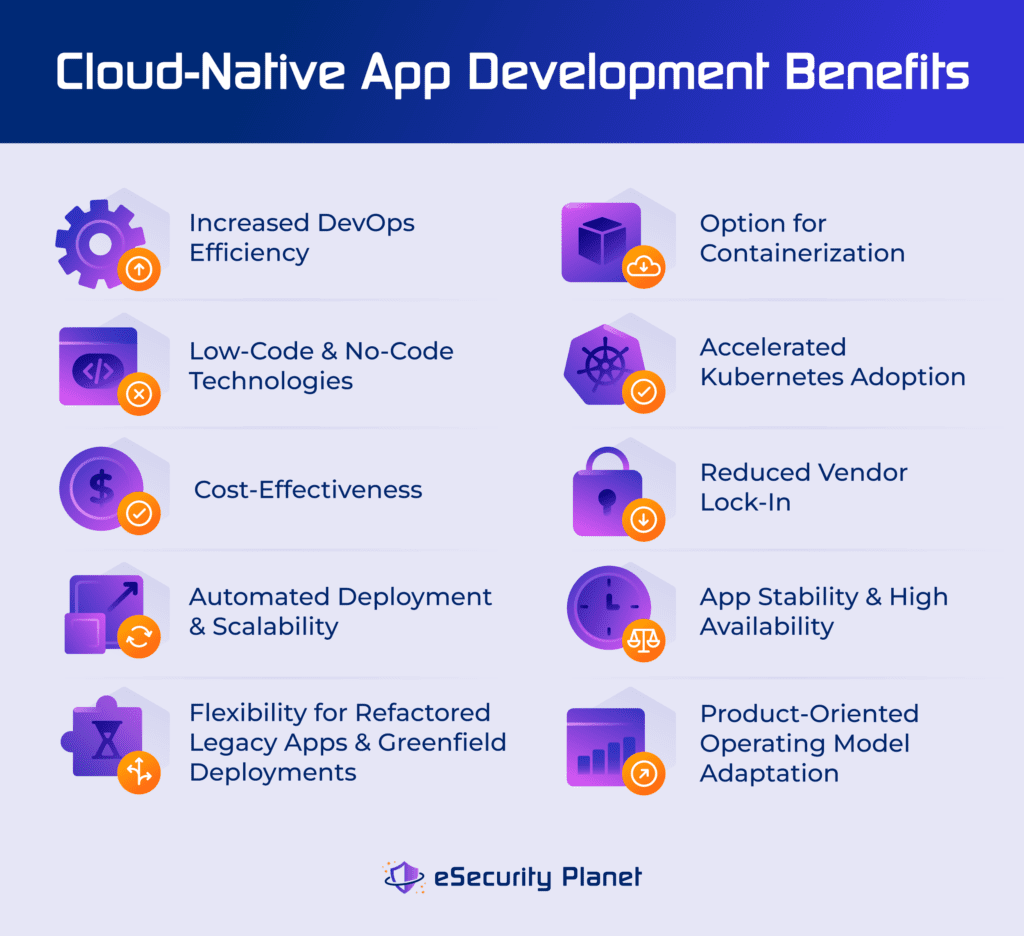Cloud-native application development combines organizational and technical changes in the design, build, and deployment of software in the cloud to deliver value faster and improve overall business efficiency. This includes using cloud-native principles, services, architecture, and DevOps processes to build scalable, flexible, and resilient systems. Explore the trends, benefits, challenges and impacts, and strategic approaches for optimizing cloud-native applications.
This article is sponsored by UST, which offers cloud service solutions trusted by major brands in healthcare, finance, retail, and more. The breadth and depth of UST’s solutions result in immediate impact and ensure a future-ready cloud infrastructure with services that include design, implementation, and governance. UST experts reimagine cloud strategy, governance models, cybersecurity, and application development to take full advantage of the cloud.
Cloud-Native Application Development Trends
Cloud-native application development is experiencing a surge. Gartner predicts that by 2025, more than 95% of new digital workloads will be deployed on cloud-native platforms. As companies increasingly learn the benefits of cloud-native architectures, this rise signals a fundamental shift away from traditional non-cloud approaches and toward a preference for cloud-native architectures as the standard deployment paradigm.
UST Sr. Director of Cloud Advisory Carl Coryell-Martin discussed these transformative capabilities of cloud-native application development with TechnologyAdvice, focusing on the importance of a successful cloud-native application service’s capacities. He reiterated that a good cloud native solution is able to give higher value “sooner, safer, and happier,” thus eliminating developer toil and fostering fast feedback loops.
However, UST’s recent report also indicates that 95% of IT and business decision-makers encountered challenges in their cloud-native technology adoption in 2023. The pain points highlighted in the survey signal a need for strategic approaches to address obstacles such as integration, visibility, and reliability and to ensure a smooth transition to this modern development standard. Addressing these maximizes the benefits of cloud-native adoption.
10 Cloud-Native Application Development Benefits
Cloud-native app development streamlines DevOps, improves integration, reduces costs, and automates deployment and scalability. Developers get flexibility for legacy and new projects, self-service infrastructure, Kubernetes efficiency, reduced vendor lock-in, increased app reliability, and simplified complexities. This approach places businesses at the forefront of streamlined efficiency and technological advancement.

Increased DevOps Efficiency
Coud-native techniques improve DevOps practices by speeding up development, deployment, and operations processes, making the software development life cycle more efficient. The shift to automated testing and deployment represents a major improvement in the software delivery process, enabling more frequent, higher-quality deployments.
Low-Code & No-Code Technologies
Application development positions itself toward assembly and integration, fueling the emergence of low-code application platforms (LCAPs) and citizen development. The democratization of application development encourages a broader range of stakeholders to engage in the development process — this results in less laborious application production and response to changing requirements.
Cost-Effectiveness
Enterprises can minimize expenses by using open-source tools, adopting serverless architectures, and implementing pay-per-use models for computing and network resources. Serverless architectures reduce the need to maintain fixed infrastructure, optimizing costs by simply paying for actual resource utilization. Open-source tools contribute to cost savings by delivering robust solutions without expensive license fees.
Automated Deployment & Scalability
Cloud-native, code-based workflows boost efficiency by automating infrastructure and application deployments, thereby eliminating error-prone manual operations. Container orchestration leverages the cloud’s flexibility to dynamically scale infrastructure, allowing it to seamlessly align with user demands.
Flexibility for Refactored Legacy Applications & Greenfield Deployments
Cloud-native techniques enable businesses to adapt and optimize legacy applications as well as newly developed projects. You can modernize and optimize existing apps rather than being stuck with old technology or architectures. Legacy systems seamlessly integrate with modern cloud infrastructure using cloud-native technologies.
Containerization
Cloud-native apps can be managed and secured independently of the hosting infrastructure by encapsulating applications and their dependencies, thereby executing reliably across several hosting environments. This independence from the underlying infrastructure allows developers to concentrate on developing and delivering apps rather than being constrained by cloud providers.
Kubernetes Adoption
Leveraging Kubernetes for container orchestration provides numerous benefits, including automating microservice deployment, management, and scalability. While there are issues with integration and storage complexity in wider Kubernetes use, containers provide a lightweight, portable, and consistent environment for deploying apps.
Reduced Vendor Lock-In
Cloud-native applications are built to be deployed seamlessly across different cloud environments, giving businesses flexibility and avoiding vendor lock-in. Cloud-native development helps eliminate reliance on a single cloud service provider, reducing vendor lock-in risks and offering enterprises the flexibility to choose and move between providers as needed.
App Stability & High Availability
An on-premises development environment is always vulnerable to downtime. The cloud, on the other hand, is always available, so there’s no disruption to the development process or apps as long as the cloud can be accessed. The resilience of microservices also ensures that the application continues to work even if one of its components fails.
Product-Oriented Operating Model
Using a product-oriented operating model integrates digital initiatives with business goals, boosting collaboration and responsiveness. This change improves workflow efficiency and adaptation to dynamic cloud environments. Introducing roles such as site reliability engineers and product managers can help further address the unique needs, ensuring a smooth transition and an organizational culture of constant advancement.
Challenges of Cloud-Native Application Development
Transitioning to cloud-native app development increases efficiencies, but it also introduces new barriers. Addressing challenges such as legacy processes, skills gaps, lack of automation, and system integration issues is key to getting the full benefits of secure cloud adoption. IT leaders have to recognize and eliminate challenges that hinder widespread adoption to ensure readiness for the evolving cloud security technology.
Legacy Processes
Legacy development processes, deeply embedded in organizational workflows, pose an integral barrier to achieving cloud-native excellence. These processes weren’t initially intended for use in cloud settings. Migrating legacy processes to the cloud only transfers their location without necessarily aligning them with the dynamic and scalable character of cloud-native systems. Prioritize reengineering over mere migration and engage in extensive workflow redesign.
Skills Gaps
The rapid cloud technology advancement frequently outpaces an organization’s acquisition of essential skills. Teams must leverage tools and practices in application deployment, orchestration, and security architecture. Bridging this skills gap involves planned training initiatives, hiring policies that prioritize cloud expertise, and promoting a culture of continuous learning.
Impacts of Cloud-Native Challenges on DevOps Teams
The challenges inherent in cloud-native application development cause a significant impact on business and DevOps teams. This includes increasing DevOps responsibilities, tool complexities, lack of standardization, scalability barriers, change management issues, and loss of legacy application functionality.
Growing DevOps Responsibilities
As cloud-native challenges persist, DevOps teams’ responsibilities expand. Beyond typical development and operations activities, DevOps teams get increasingly involved in security, compliance, and coordination with IT operations. Effective communication with ITOps and/or SecOps, as well as aligning objectives with infrastructure and security teams, can create a unified and secure development pipeline.
Tool Complexities & Lack of Standardization
Managing a broad range of tools for container orchestration, monitoring, and deployment leads to integration issues and more cognitive load. DevOps teams may struggle to establish standardized methods throughout the development lifecycle, resulting in inefficiencies, longer learning curves, and potential errors.
Scalability Barriers
Scalability barriers, whether in terms of technology, methods, or team competencies, might hamper DevOps teams’ ability to fulfill the needs of a developing cloud-native environment. Failure to scale efficiently can lead to bottlenecks, poor performance, and delays in providing applications to end users. To meet the organization’s growing demands, DevOps teams must depend on automation and efficient resource management.
Change Management Issues
While boosting efficiency, continuous integration and continuous deployment (CI/CD) pipelines also increase the frequency of changes. Ensure that you carefully and effectively manage these changes and that there are minimal disruptions to operations, then confirm the impact on security and compliance.
Loss of Legacy Application Functionality
When integrating legacy applications into new cloud-native ecosystems, compatibility difficulties, reliance on obsolete frameworks, and the requirement for extensive restructuring can all pose challenges. It may result in loss of legacy application functionality, which impacts the DevOps teams in charge of maintaining and evolving these applications.
Strategic Approaches for Optimizing Cloud-Native Application Development
Unlocking the full benefits of cloud-native application development needs strategic initiatives such as faster transitions via third-party support, skill enhancement programs, platform engineering adoption, and assessing success metrics.
Expedite Transitions through Third-Party Support
82% of enterprises surveyed already use cloud-native development approaches and tools, but most are making little headway. This, in turn, leads most enterprises to actively seek a third-party partner to support their cloud-native development needs as leveraging third-party expertise can speed up transitions, enhance security, and streamline development processes.
Enterprises also turn to third-party support to manage the increasing cloud usage and costs. Key focus areas for companies also include securing cloud infrastructure; automating application testing, deployment, or monitoring; transforming legacy applications for the cloud; and choosing an appropriate technology as well as implementation and integration methods.
Establish Skill Enhancement Programs
Enterprises should invest in skill enhancement programs for their teams. Review current capabilities and identify gaps in knowledge. Define role-specific learning routes that include topics such as cloud platforms, microservices, and DevOps. Choose from a variety of training tools, such as online courses and certificates. Encourage internal knowledge sharing and dedicate time for continual learning.
Adopt Platform Engineering
This strategy involves the creation and upkeep of a developer platform to expedite application development and deployment. The platform acts as a foundation, providing self-service APIs, tools, services, knowledge, and support in the form of a unified internal product.
Implementing platform engineering practices aims to achieve several goals:
- Reduce cognitive load for users: Platforms reduce cognitive load for users by hiding complex architectural details, allowing teams to focus on designing features without being swamped by infrastructure complexities.
- Improve reliability and resiliency: One principle is to assign experts to configure and monitor platform capabilities. Centralizing expertise and governance ensures that services are resilient and stable enough to withstand failures.
- Accelerate product development and delivery: Platform engineering accelerates the development lifecycle by utilizing pre-built tools and shared knowledge. Reusing components and best practices improves efficiency and consistency.
- Lower risk of security, regulatory, and functional issues: Leveraging platforms can lower the possibility of security breaches, ensure compliance, and reduce the risk of functional difficulties in products and services by enforcing standards and controls.
- Automate and standardize processes: By optimizing workflows, reducing manual intervention, and improving process reliability, these processes assure consistency and reproducibility across the development lifecycle.
- Leverage self-service infrastructure provisioning: Self-service interfaces enable teams to access resources on-demand, decreasing bottlenecks, increasing scalability, and removing manual stages in the development process.
- Use containerization for scalability and resource utilization: Prioritize containerization for scalability, portability, and efficient resource utilization, resulting in a uniform, lightweight environment for programs.
- Apply collaborative DevOps practices: The platform combines with collaboration tools to provide smooth communication and coordination between development, operations, and other stakeholders, fostering a cohesive ecosystem and breaking down silos.
Evaluate Success via Recommended Metrics
Regularly monitoring and evaluating key metrics in cloud-native gives DevOps teams and stakeholders significant insights into the performance, efficiency, and dependability of cloud-native apps. Continuous improvement based on indicators such as high deployment frequency, short lead time for changes, auto-scaling success, and low application error rates assists companies in adapting to changing needs and delivering optimal results.
Consider these metrics to assess the effectiveness of your cloud-native applications:
- High deployment frequency: A high deployment frequency indicates an agile and efficient development process in which teams can respond rapidly to business needs, supply new functionality, and adapt to changing requirements.
- Short lead time for changes: Short development lead times indicate a simplified and fast-paced development process. It means that the period between envisioning a change and putting it into production is short, suggesting swift innovation and response.
- Recovery time: This metric indicates the speed with which services can be restored following a malfunction or outage. Quick and efficient incident response and recovery processes suggest a well-prepared system, thus minimizing downtime.
- Application error rates: Low error rates suggest a stable and well-maintained program, contributing to a positive user experience and minimizing disruptions by tracking the frequency and severity of problems or faults in the application.
- Change failure rates: A low change failure rate indicates a stable and dependable deployment procedure, implying that changes are extensively vetted and the possibility of introducing mistakes or difficulties into the production environment is minimal.
- High availability/uptime: This shows the percentage of time the application is operational and available. High availability ensures that users can use the program whenever they need it, which improves customer satisfaction and business continuity.
- Security incidents rate: This rate monitors the frequency of security issues like breaches and unauthorized access. A low rate of security incidents suggests that the security measures in place are effective.
- High IaC compliance: A high level of Infrastructure as Code (IaC) compliance promotes consistency, reproducibility, and version control in infrastructure management, lowering the risk of configuration drift and improving security.
Bottom Line: Unlock the Full Benefits of Cloud-Native Application Development
Cloud-native application development is an instrumental strategy for businesses seeking to maintain a competitive edge in the industry. The versatility of cloud-native practices empowers developers to seamlessly adapt and optimize both legacy applications and new deployments and takes full advantage of the cloud’s flexibility. Despite its inherent limitations, its modular architecture provides more speed and flexibility that traditional systems cannot match.




